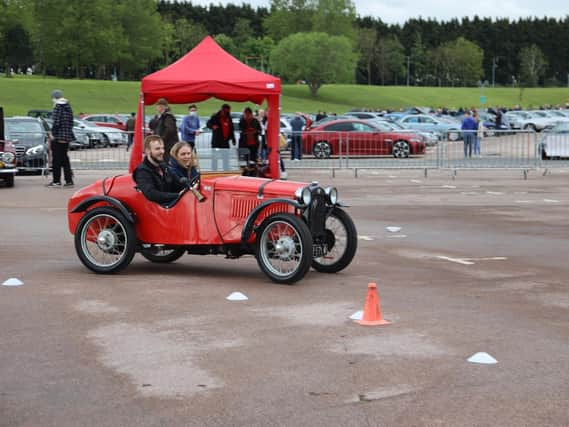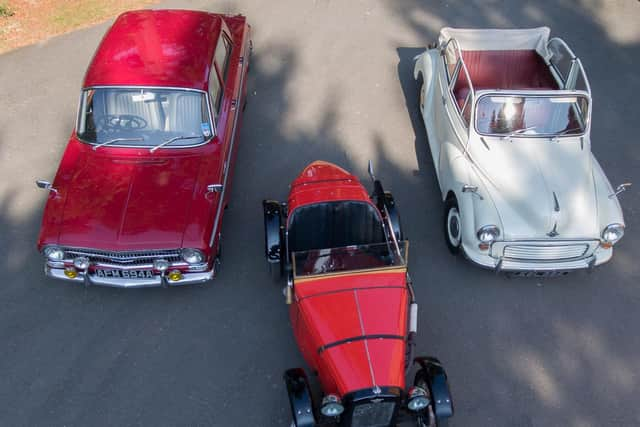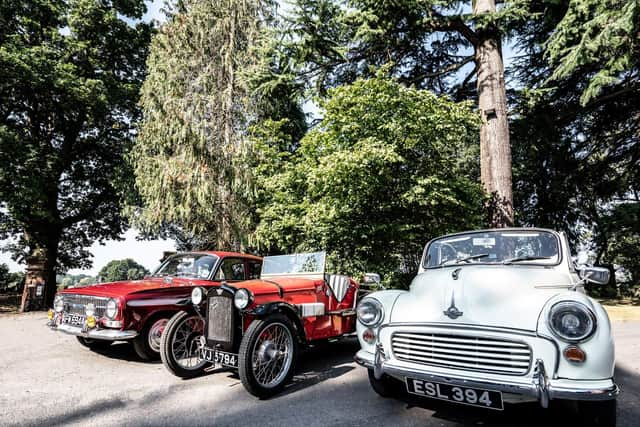We drove three iconic British classics at Gaydon's motor museum, and so can anyone else aged 10 upwards


Young people (and adults) now have the chance to drive stunning classic cars at Gaydon's British Motor Museum as part of a programme to drive-down the high accident rate among new drivers.
Organised by Young Driver and hosted by the museum, the classic car driving experiences were launched by TV presenter and car expert Quentin Willson on Saturday, May 22 - and we were invited along.
Advertisement
Hide AdAdvertisement
Hide AdThe driving experiences allow people aged 10 upwards to have the chance to drive a Vauxhall VX490, Morris Minor or a 90-year-old Austin 7.


Young Driver, which more typically offers lessons to 10 - 17 year olds in brand new Vauxhall Corsa SE Premiums at 70 venues across the UK, has included classic cars in their programme because they believe they offer a unique advantage in teaching safety to young people.
When we arrived at the launch event we spoke with Quentin Willson, who has served as patron of the group for many years.
He said: "The principle is to make safer drivers - and to do this we want to teach young people what's under the bonnet before they get behind the wheel.
Advertisement
Hide AdAdvertisement
Hide Ad"When you get a 17-year-old in the driver's seat they're often not interested in learning about hazard perception.


"But if you get a 13-year-old behind the wheel of one of these cars you have their full attention."
Although the driving school uses a fleet of up-to-date cars, Quentin said he believes there is a unique value in getting young people driving classics.
Quentin explained that modern cars are incredibly forgiving of poor driving skills, whether that be control or reaction to hazards.
Advertisement
Hide AdAdvertisement
Hide AdBut classics demand precise, skilled driving and the ability to plan ahead - and if a young person then combines those skills with a much-better equipped modern car, the theory is that they will be drastically safer on the roads.
Quentin added: "We really believe this is making people safer. We would love to get this in schools and have people taught about this from a young age - but sadly anything to do with driving is not considered politically correct now."
Then it was time to get driving.
So here it is, our review of all three cars, with a look at what sort of young person might like each one.
Car no.1, the Morris Minor
The first car of the day was a Morris Minor - an instantly recognisable British classic which has held the nation's affection for more than 70 years.
Advertisement
Hide AdAdvertisement
Hide AdDesigned by Sir Alec Issigonis (the mastermind behind the Mini), the Moggie first rolled off the production line in 1948.
With its beautiful, American-inspired design and happy chrome face it is hard to grasp how spellbinding this little car must have been on the roads of post-war Britain, where soot and bombed-out buildings were a ubiquitous sight.
My Moggie for the day is a later version, dating back to 1962. It's cream with a soft top roof and the slightly more powerful 1100cc engine.
The first thing that struck me was the aircraft-like thinness and lightness of the doors - I've never known anything that manages to feel flimsy and bank-vault solid at the same time.
Advertisement
Hide AdAdvertisement
Hide AdThe second was the seat. It puts anything in any car I have been in to shame. There are no sport or 'performance' pretensions here, you're given a soft leather mass to sink into.
Paul my instructor knows just about everything about these cars - he climbs into the passenger seat, gives me a quick rundown of the car's history and then a few words of advice on how it differs to the modern cars I'm used to.
The little A-Series engine, which was manufactured in various guises up to the turn of the century, makes a cheerful (if slightly agricultural) sound.
I'm away quickly, and I'm shocked at how nippy the little Moggie is.
Advertisement
Hide AdAdvertisement
Hide AdPulling away is effortless, I've known worse clutches on ten-year-old cars and the torque of the A-Series engine makes it feel like the car is powered by steam.
Obviously - there is no power steering - but the car is so light that as soon as you're moving you barely notice it. In fact, in an age of power electric power steering, the Moggie's wheel feels very precise and nicely weighted. A go at the slalom was effortless.
The gear box was a little like stirring porridge - but given that ratios in the four-speed box are very tall and we're not on the open road, anything more than second isn't required.
Paul tells me the box wouldn't have been quite that vague out of the factory.
Advertisement
Hide AdAdvertisement
Hide AdIf I'm honest, I would happily drive this car in modern traffic and be confident it could cope. The brakes are obviously not very effective compared with beefed-up modern discs so plenty of forward planning would be required. You're certainly only ever going to come to a gentle stop no matter how hard you stamp on the pedal.
Overall, the Moggie is a fantastic little machine. Incredibly easy to drive and there's no surprise it was, and remains, such a cherished car.
What would it be like for a young person?
As said, the Moggie is an easy car to drive. The clutch is very forgiving and the torquey engine means it would be difficult to stall. The steering is nowhere near heavy enough to phase smaller people and it's a genuinely fun drive.
Car no.2, the Austin 7 - Ulster conversion
Some of you might be old and wise enough to remember seeing the Austin 7 saloon on Britain's roads.
Advertisement
Hide AdAdvertisement
Hide AdManufactured through the 1920s and 1930s, the car was well-loved and robust enough that many were in regular service long after the war.
The motor museum has an example inside which was found many years after the war being used to pull boats in.
My Austin 7 for the day was no ordinary four-seater saloon - this is an Ulster conversion - a barmy, open-topped two-seater with no doors.
It's pushing 90 years old - but the thing roars into life and the engine shakes the car.
Advertisement
Hide AdAdvertisement
Hide AdAnyone over about 5 foot 5 tall will find getting in a hilarious exercise and the cab is more suited to people of yesteryear - it seems a diet of cigarettes and Al Bowly wasn't conducive to growing anyone beyond the size of a child.
The Austin's engine, like many of that time, has a small cc rating and modest bhp figures - but its long stroke means it has enough torque to win a tug-of-war against an elephant.
This means that its clutch, a minute little pedal that requires nothing but brute force to engage all the way, isn't too much of an issue.
Pulling away is easy, then, and once you're going that change into second is simple (providing you practically push the clutch through the floor).
Advertisement
Hide AdAdvertisement
Hide AdAgain, the gears are very tall, so the fact the change into third is very tricky doesn't really matter. Second is enough for to have some real fun in the space allocated.
And fun really is the operative word here. In this car, 15mph feels like 150. The steering is razor sharp, a small movement either way will send the car hurtling round a corner.
It changes direction like a bluebottle and if you push it you feel the back wheels threaten to let go in a glorious way that anyone acquainted with a modern rear-wheel drive car will recognise.
The little Austin make a racket, stinks of fumes and makes you feel like you're breaking the land speed record - and all at 15mph.
Advertisement
Hide AdAdvertisement
Hide AdThis car constantly chatters at you, telling you exactly what's happening on the road surface and how you're doing for traction, something that very few machines built nowadays do.
Needless to say, the brakes will stop you in their own good time.
What would it be like for a young person?
Any young person put behind the wheel of the Austin is in significant danger of becoming a car enthusiast for life. I did mention the agricultural nature of the clutch - but smaller people would probably have an easier time of it because they would be able to do the contortions required to get a good press on it.
The torque means that stalling this car is practically impossible. Not only is the Austin heaps of fun to drive, its 'thrill ride' handling at even low speeds and its marshmallow brakes will go far to educate a young person as to just how much work the car is doing to stop them ending up in a ditch. Don't fear, though, for all that, the Austin is incredibly stable and compliant - choose this car if your young'un likes a bit of excitement, but be assured they'll be perfectly safe in it.
Car no.3, the Vauxhall VX490
Advertisement
Hide AdAdvertisement
Hide AdI'm ready to admit that I knew nothing about this car. I don't feel too bad, though, because Quentin explained that these are now exceptionally rare - with fewer than 10 examples left on our country's roads. This was, by the way, his favourite of the three.
The Vauxhall, built in around 1962 and aimed to appeal to Americans as well as Brits, is about as far from the Morris Minor as you could get.
It's an ocean liner of a car, comparable in size with a brand-new family saloon.
Walnut and leather abound in the comfy interior. When considering that this car was built at the same time as the Moggie - and only 30 years after the Austin - it's mindbogglingly modern.
Advertisement
Hide AdAdvertisement
Hide AdSomeone not familiar with the model could be fooled into thinking this is from the eighties - and that effect only gets greater when you drive it.
The pedals have barely any weighting to them - the clutch is probably the smoothest I've ever known in a car.
Pulling away is a breeze because of this, and when you get underway you quickly notice the American influence.
We've all seen those old American films where a car chase consists of lumbering barges taking corners so quickly that the wheel arch is practically touching the tyre - and this is that.
Advertisement
Hide AdAdvertisement
Hide AdIt translates tarmac into sponge and rolls around the corners. I could happily have joined the motorway and driven this all the way to Scotland - it's like driving a lounge.
Drivers' tastes these days have produced some very strange vehicles - the sensible family saloon has been replaced by hordes of 'crossovers', fitted with sports bucket seats and low-profile alloy wheels.
In other words, many of us favour cars that are supposed to be comfortable - but we wreck any comfort they have by demanding they have fittings that are intended for performance cars.
This Vauxhall then, harks back to an age where there was confidence enough to drive an armchair of a car without fitting it with something more suited to something you'd take to the track every Sunday.
Advertisement
Hide AdAdvertisement
Hide AdThere were plenty of sports cars and seriously quick saloons on offer back then - but the sort of person who bought this Vauxhall didn't care about that. Sure, it'll go like a steam train on the motorway, or get you away from the aftermath of a bank job, but they were far too laid back to ever need to blast around.
And because of that, it's genuinely cool. In a way that modern 'sensible' cars dressed up to look sporty just aren't. If this car had a soundtrack, it would be Come Together by the Beatles.
Ever wanted to feel like you're in a Martin Scorsese film? Drive this.
What would it be like for a young person?
This car lacks the cult status of the Morris and the Spitfire-esque handling of the Austin, but it's undeniably fun. The controls are by far the easiest to use and the steering, although a little heavy, shouldn't be too much of an issue for the average teen.
Advertisement
Hide AdAdvertisement
Hide AdIt was clearly designed as a highway cruiser and the brakes, being all drums, are far from overwhelming. So although this the most modern-feeling car by miles, any young person driving this will still get the point of these events - an education in the limits of cars to rectify bad driving decisions.
How can I book a place?
The driving experiences last 15 minutes and those booking a lesson also get discounted entry into the museum. The cost per lesson is £25.
You can check when the next event is due and book places by visiting www.britishmotormuseum.co.uk/whats-on